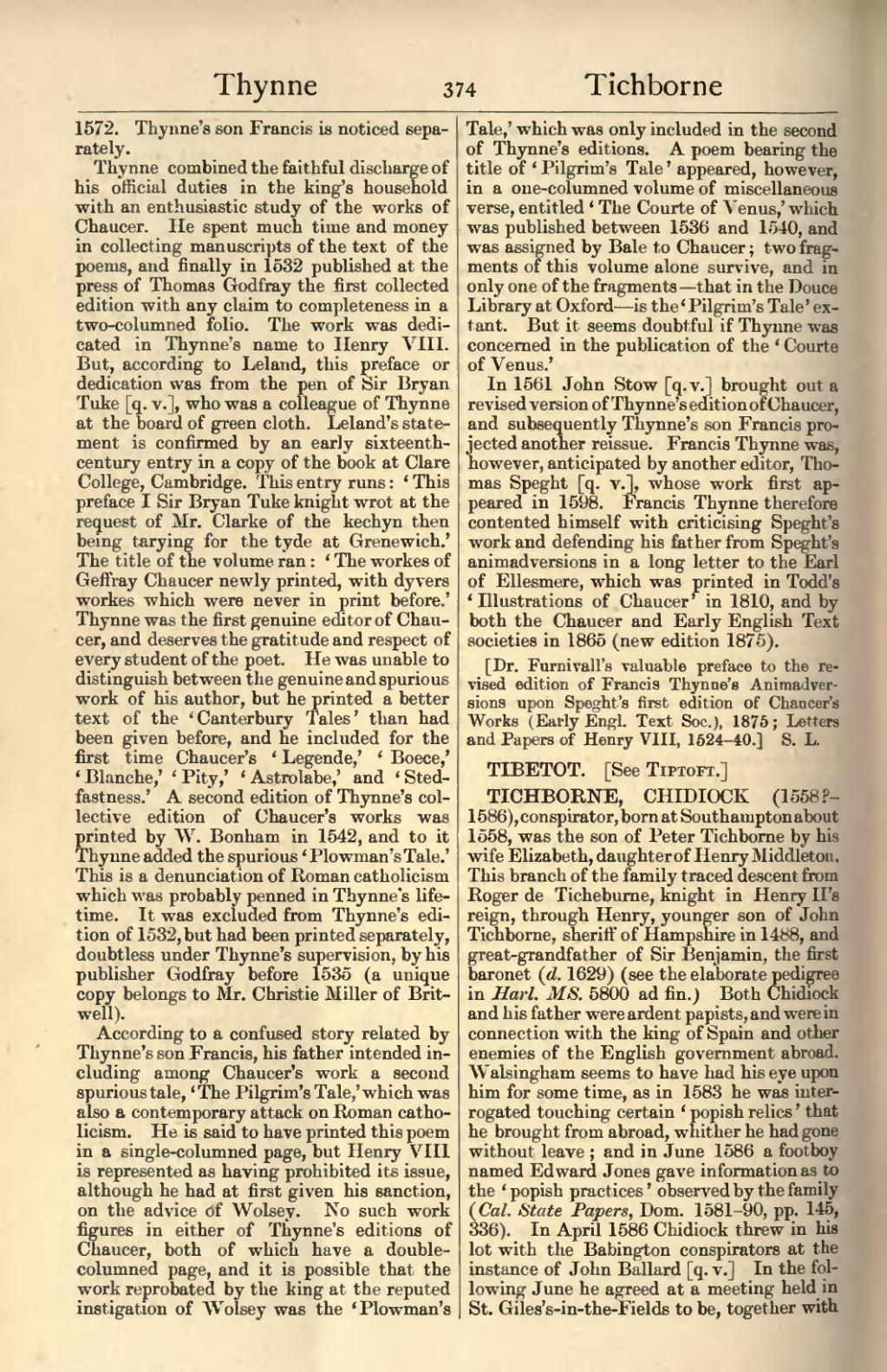1572. Thynne's son Francis is noticed separately.
Thynne combined the faithful discharge of his official duties in the king's household with an enthusiastic study of the works of Chaucer. He spent much time and money in collecting manuscripts of the text of the poems, and finally in 1532 published at the press of Thomas Godfray the first collected edition with any claim to completeness in a two-columned folio. The work was dedicated in Thynne's name to Henry VIII. But, according to Leland, this preface or dedication was from the pen of Sir Bryan Tuke [q. v.], who was a colleague of Thynne at the board of green cloth. Leland's statement is confirmed by an early sixteenth-century entry in a copy of the book at Clare College, Cambridge. This entry runs: 'This preface I Sir Bryan Tuke knight wrot at the request of Mr. Clarke of the kechyn then being tarying for the tyde at Grenewich.' The title of the volume ran: 'The workes of Geffray Chaucer newly printed, with dyvers workes which were never in print before.' Thynne was the first genuine editor of Chaucer, and deserves the gratitude and respect of every student of the poet. He was unable to distinguish between the genuine and spurious work of his author, but he printed a better text of the 'Canterbury Tales' than had been given before, and he included for the first time Chaucer's 'Legende,' 'Boece,' 'Blanche,' 'Pity,' 'Astrolabe,' and 'Stedfastness.' A second edition of Thynne's collective edition of Chaucer's works was printed by W. Bonham in 1542, and to it Thynne added the spurious 'Plowman's Tale.' This is a denunciation of Roman Catholicism which was probably penned in Thynne's lifetime. It was excluded from Thynne's edition of 1532, but had been printed separately, doubtless under Thynne's supervision, by his publisher Godfray before 1535 (a unique copy belongs to Mr. Christie Miller of Britwell).
According to a confused story related by Thynne's son Francis, his father intended including among Chaucer's work a second spurious tale, 'The Pilgrim's Tale,' which was also a contemporary attack on Roman Catholicism. He is said to have printed this poem in a single-columned page, but Henry VIII is represented as having prohibited its issue, although he had at first given his sanction, on the advice of Wolsey. No such work figures in either of Thynne's editions of Chaucer, both of which have a double-columned page, and it is possible that the work reprobated by the king at the reputed instigation of Wolsey was the 'Plowman's Tale,' which was only included in the second of Thynne's editions. A poem bearing the title of 'Pilgrim's Tale' appeared, however, in a one-columned volume of miscellaneous verse, entitled 'The Courte of Venus,' which was published between 1536 and 1540, and was assigned by Bale to Chaucer ; two fragments of this volume alone survive, and in only one of the fragments that in the Douce Library at Oxford is the 'Pilgrim's Tale' extant. But it seems doubtful if Thynne was concerned in the publication of the 'Courte of Venus.'
In 1561 John Stow [q.v.] brought out a revised version of Thynne's edition of Chaucer, and subsequently Thynne's son Francis projected another reissue. Francis Thynne was, however, anticipated by another editor, Thomas Speght [q. v.], whose work first appeared in 1598. Francis Thynne therefore contented himself with criticising Speght's work and defending his father from Speght's animadversions in a long letter to the Earl of Ellesmere, which was printed in Todd's 'Illustrations of Chaucer' in 1810, and by both the Chaucer and Early English Text societies in 1865 (new edition 1875).
[Dr. Furnivall's valuable preface to the revised edition of Francis Thynne's Animadversions upon Speght's first edition of Chaucer's Works (Early Engl. Text Soc.), 1875; Letters and Papers of Henry VIII, 1524-40.]
TIBETOT. [See Tiptoft.]
TICHBORNE, CHIDIOCK (1558?–1586), conspirator, born at Southampton about 1558, was the son of Peter Tichborne by his wife Elizabeth, daughter of Henry Middleton. This branch of the family traced descent from Roger de Ticheburne, knight in Henry II's reign, through Henry, younger son of John Tichborne, sheriff of Hampshire in 1488, and great-grandfather of Sir Benjamin, the first baronet (d. 1629) (see the elaborate pedigree in Harl. MS. 5800 ad fin.) Both Chidiock and his father were ardent papists, and were in connection with the king of Spain and other enemies of the English government abroad. Walsingham seems to have had his eye upon him for some time, as in 1583 he was interrogated touching certain ‘popish relics’ that he brought from abroad, whither he had gone without leave; and in June 1586 a footboy named Edward Jones gave information as to the ‘popish practices’ observed by the family (Cal. State Papers, Dom. 1581–90, pp. 145, 336). In April 1586 Chidiock threw in his lot with the Babington conspirators at the instance of John Ballard [q. v.] In the following June he agreed at a meeting held in St. Giles's-in-the-Fields to be, together with
